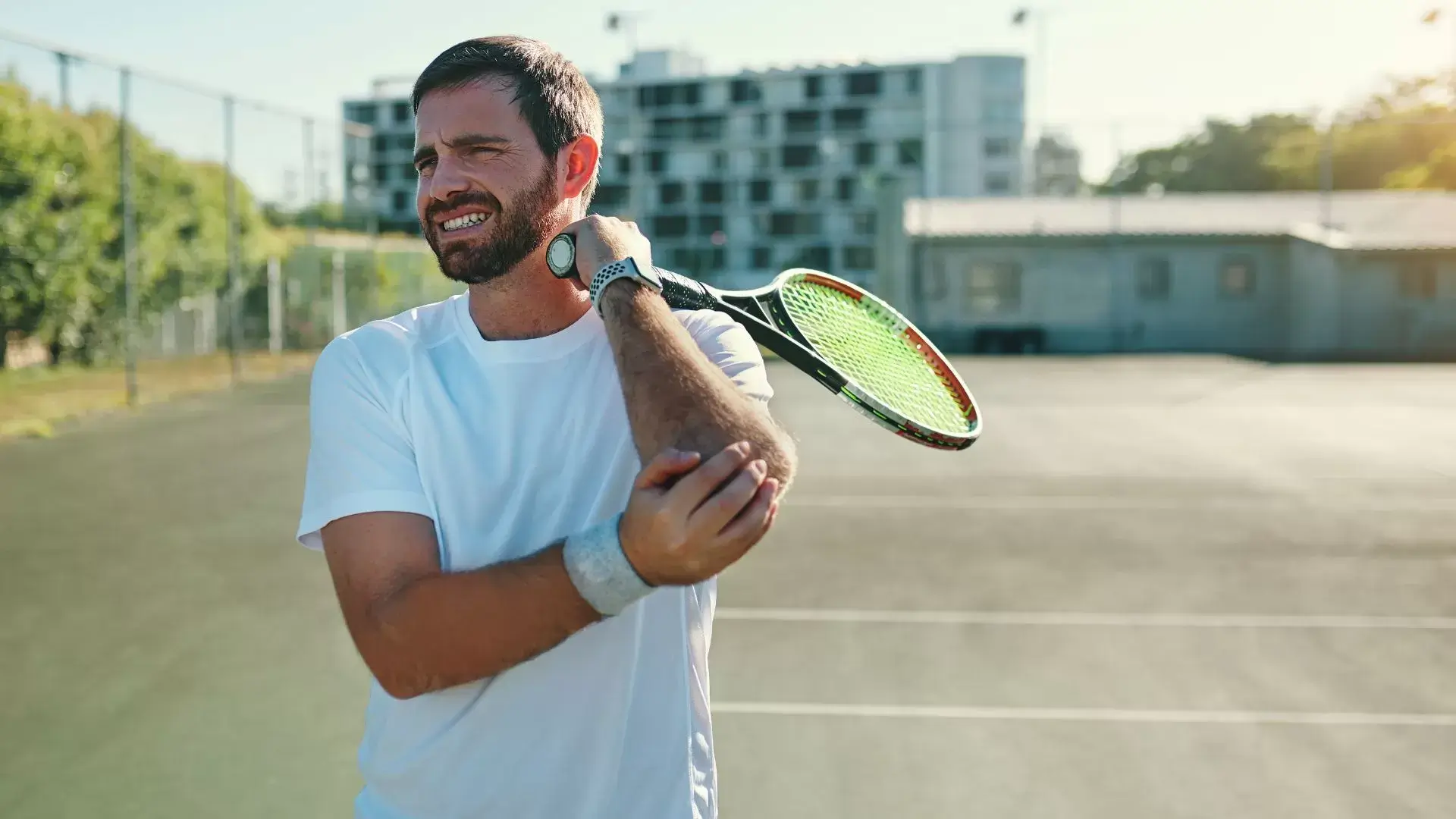Physiotherapy for Tennis Elbow is essential for effective pain relief and recovery. We recognize that dealing with tennis elbow can be frustrating and painful. In Mississauga, our physiotherapy services focus on tailored recovery strategies to help alleviate pain and restore function. We assess your specific condition and may use techniques like manual therapy, ultrasound, and targeted exercises to promote healing. Ice and heat therapy, along with ergonomic adjustments, can also support your recovery. Our compassionate team is committed to providing you with the support and techniques necessary for long-lasting relief. To discover how we can assist you further, we invite you to learn more about our extensive approach to treatment.

At Mississauga Physio Chiro Clinic, we offer a thorough range of physiotherapy and chiropractic services tailored to effectively address conditions like tennis elbow. We recognize that elbow pain can greatly impact daily activities and sports performance, so our approach focuses on extensive pain management and rehabilitation strategies.
Our Experienced Physiotherapist & Chiropractor in Mississauga utilizes manual therapy and therapeutic massage to reduce tendon inflammation and alleviate discomfort. We also emphasize the importance of tailored elbow mobility exercises to restore function and strength. In combination with our sports rehabilitation programs, we guarantee that our clients receive the best possible care to facilitate recovery.
For those experiencing chronic pain, we provide targeted interventions designed to promote chronic pain relief and improve overall well-being. Our physiotherapy and chiropractic services are customized to meet individual needs, whether it’s for a recent injury or ongoing challenges.
Tennis elbow not only causes pain but can greatly hinder arm strength and mobility, making everyday tasks and sports activities increasingly challenging. As we experience lateral epicondylitis, the resulting forearm pain can lead to significant grip weakness and elbow stiffness. This impacts our ability to perform simple actions like lifting a cup or shaking hands, limiting our overall elbow function.
Chronic elbow pain often becomes a frustrating barrier, preventing us from engaging in our favorite sports or hobbies. The decreased elbow mobility that accompanies tennis elbow can make it difficult to execute movements, further exacerbating our discomfort.
To combat these issues, we can explore various pain relief therapy options and focus on elbow strengthening exercises. By incorporating targeted rehabilitation techniques, we can improve our elbow function and regain lost strength. Understanding the effects of tennis elbow on our daily lives empowers us to seek appropriate treatment and make informed decisions about our recovery. With the right approach, we can restore our arm’s mobility and strength, allowing us to return to the activities we love without limitation.
Understanding the common risk factors and triggers for tennis elbow is essential in preventing this painful condition from disrupting our daily activities and athletic pursuits. Tennis elbow, or lateral epicondylitis, often arises from tendon degeneration due to repetitive stress injuries. Engaging in activities that strain the wrist extensor muscles, such as racket sports or manual labor, puts us at risk for overuse injuries.
We should also consider factors like muscle fatigue and improper ergonomics in our workspaces. If we’re constantly straining our elbows without ergonomic adjustments, we might experience elbow swelling and persistent arm pain, signaling the onset of this condition.
Interestingly, those who play sports like tennis are not the only ones affected; individuals with golfer’s elbow, or medial epicondylitis, can also face similar risks due to muscle imbalances. By being mindful of these triggers, we can take proactive steps to minimize elbow strain and maintain our physical well-being. Awareness of these factors empowers us to make necessary adjustments in our routines, ensuring we remain active and pain-free.
Recognizing the key symptoms of tennis elbow is essential for us to address pain and mobility issues before they escalate. One common symptom we often experience is acute elbow pain, especially on the outer part of our elbow. This pain can sometimes radiate down to the wrist, leading to wrist pain that makes daily activities challenging. We may also notice stiffness in our forearm muscles, which can affect our elbow flexibility.
As a repetitive motion injury, tennis elbow is often aggravated by activities that require gripping or lifting. We should pay attention to any discomfort during these tasks, as it can signal the need for inflammation relief. In addition, reduced joint stability can make us more susceptible to further injury, emphasizing the importance of recognizing these symptoms early.
Engaging in resistance exercises may help strengthen our forearm muscles and support elbow recovery. It’s vital that we don’t ignore persistent symptoms, as timely intervention can greatly improve our overall well-being. By being vigilant and proactive, we can effectively manage tennis elbow and maintain our active lifestyle.

Effective physiotherapy plays an essential role in our recovery from tennis elbow, helping to alleviate pain and restore function through targeted exercises and techniques. We often start with a thorough assessment to identify the extent of elbow tendinopathy, allowing us to create a personalized recovery plan. Physical therapy typically incorporates a variety of methods, such as stretching exercises to improve flexibility and forearm strengthening to support the elbow joint.
In addition, we use ice therapy to reduce inflammation and pain, while heat therapy can help relax the muscles and enhance blood flow. Kinesiology taping may also be employed to provide elbow support and stability during movement. Anti-inflammatory treatments are often recommended to further aid in pain management.
Joint mobilization techniques can help improve the range of motion in the elbow, encouraging proper movement patterns as we recover. Our goal is to empower you with knowledge and techniques that promote healing and prevent future injuries. By committing to a structured physiotherapy program, we can work together to achieve ideal recovery and get back to the activities we love.
A variety of targeted physiotherapy techniques can markedly enhance our approach to treating tennis elbow, promoting both pain relief and functional recovery. One effective method involves the use of ultrasound therapy, which helps reduce inflammation around the elbow tendons and improves blood flow to the elbow joint. Additionally, we may incorporate shockwave therapy to stimulate healing and alleviate pain.
For those experiencing significant discomfort, corticosteroid injections can provide temporary relief, allowing us to progress with other treatments. We also consider PRP therapy, which utilizes the body’s platelets to accelerate healing in the elbow tendons.
To support the healing process, we often recommend wearing an elbow brace or elbow orthotics. These devices stabilize the joint and reduce strain during daily activities. Myofascial release techniques can further alleviate tension in surrounding muscles, enhancing overall mobility.
Moreover, occupational therapy plays an essential role in helping individuals adapt their daily tasks, ensuring they can manage their symptoms effectively. By combining these techniques, we can develop a thorough treatment plan tailored to each individual’s needs, ultimately fostering a smoother recovery from tennis elbow.
Incorporating specific strengthening and stretching exercises into our rehabilitation program is fundamental for restoring function and alleviating pain in those suffering from tennis elbow. These exercises play a significant role in improving elbow mechanics and promoting tendon healing, ultimately aiding in recovery from this common sports injury or manual labor injury.
We can start with gentle stretching exercises to enhance flexibility and reduce stiffness in the forearm muscles. Gradually integrating strengthening exercises helps build endurance and stability in the elbow joint, which is essential for preventing further injury. By focusing on the muscles surrounding the elbow, we can effectively support our recovery and prevent future occurrences.
Neuromuscular therapy can also be beneficial, as it helps improve coordination and control in the muscles involved. This holistic approach to non-surgical treatment guarantees we not only address the immediate pain but also strengthen the underlying structures supporting the elbow.
Together, we’ll create a tailored rehabilitation plan that includes these crucial exercises, allowing us to regain function, reduce discomfort, and return to our daily activities with confidence. Remember, consistency is key in our recovery journey.
How can we best manage the pain associated with tennis elbow while facilitating our recovery? First, we need to identify the underlying causes of our discomfort, which often stems from elbow tendonitis. Whether it’s a work-related injury from repetitive tasks, a racket sports injury, or a gripping injury, recognizing the source helps us choose appropriate relief strategies.
To alleviate pain, we can use elbow splints to support our joints and reduce strain. Additionally, addressing any muscle imbalances and enhancing wrist stability through targeted exercises plays an important role in our recovery. If we’re experiencing symptoms of golfer’s elbow or nerve compression, it’s vital to consult a physiotherapist for tailored guidance.
Incorporating rest and ice therapy can further manage inflammation, while gentle stretching and strengthening exercises can promote healing. We should also consider modifying our activities to avoid exacerbating our condition from throwing injuries or repetitive motions. By employing these strategies, we can effectively manage our pain and support our journey towards recovery, ensuring we’re back to our normal activities as soon as possible.

Shockwave and ultrasound therapy are frequently utilized techniques that can greatly enhance our recovery process from tennis elbow by promoting tissue healing and reducing pain. At our clinic located at 1834 Lakeshore Rd W #6C, Mississauga, ON L5J 1J7, we employ these innovative therapies to target the extensor tendons and alleviate discomfort associated with the radial nerve and elbow ligament injuries.
By delivering acoustic waves to the affected area, shockwave therapy stimulates blood flow and accelerates healing. Ultrasound therapy further complements this by providing deep tissue penetration, improving tissue elasticity, and reducing inflammation. These methods are particularly effective for conditions like tennis elbow and golfer’s elbow, helping us regain ideal arm biomechanics without the need for invasive procedures such as elbow surgery.
Our team understands the impact of elbow pain on daily activities and is committed to supporting you through this journey. For more information or to schedule an appointment, feel free to contact us. Together, we can work towards restoring your mobility and enhancing your quality of life, enabling you to engage in your favorite activities pain-free.
Braces, kinesiology taping, and orthotics play an important role in providing support and stability to the elbow, helping us manage the discomfort associated with tennis elbow effectively. These tools serve to alleviate strain on the affected muscles and tendons, promoting a quicker recovery.
Braces are designed to limit movement in the elbow while providing compression, which can greatly reduce pain during daily activities. They come in various styles, allowing us to choose one that fits our lifestyle and comfort level.
Kinesiology taping is another beneficial technique we can use. This method involves applying a special elastic tape to the skin, which may help improve circulation and support the muscles, reducing the feeling of discomfort without restricting our range of motion.
Orthotics, such as wrist supports, can also play an important role. By properly aligning the wrist and forearm, they help to minimize the load on the elbow joint, allowing us to engage in daily activities with less pain.
Together, these supportive measures not only enhance our recovery process but also empower us to return to our normal routines with confidence and reduced discomfort.
What adjustments can we make in our workplace and daily lives to effectively reduce strain on our elbows and support recovery from tennis elbow? First, let’s assess our workspace ergonomics. Ensuring our desk is at the right height can prevent unnecessary strain. We should use chairs that provide support and keep our wrists in a neutral position while typing. If possible, we might consider ergonomic keyboards or mice designed to minimize elbow tension.
In addition to workspace adjustments, we can also make lifestyle changes. For instance, incorporating regular breaks into our daily routine allows our muscles to relax and recover. During these breaks, gentle stretching can help maintain flexibility and reduce stiffness.
We should also be mindful of how we perform daily tasks. Using both hands when carrying or lifting objects can distribute the load more evenly, notably reducing strain on our elbows. Finally, we might want to limit repetitive motions, such as excessive gripping or twisting, which can exacerbate symptoms. By implementing these adjustments, we can create a supportive environment that fosters recovery and helps us manage our elbow strain effectively.
Even with workplace and lifestyle adjustments in place, many of us may still experience chronic tennis elbow and persistent discomfort that requires additional strategies for effective management. Understanding that this condition can be frustrating, we can explore several methods to alleviate our symptoms.
First, we should consider targeted physiotherapy, where a professional can guide us through specific exercises aimed at strengthening the muscles around our elbow. This not only promotes healing but also prevents further strain. Additionally, modalities like ultrasound or electrical stimulation might offer relief by reducing inflammation and pain.
Ice therapy can also be beneficial, especially after activities that exacerbate our discomfort. By applying ice packs for 15-20 minutes, we can help manage swelling and pain. Moreover, we might explore the use of braces or forearm straps, which can provide support and limit stress on our elbow during daily tasks.
To effectively prevent tennis elbow, we should focus on incorporating strength training and injury prevention strategies into our routine. Strengthening the muscles of our forearm can provide better support to our elbow joint, reducing the risk of strain. We can start with exercises targeting the wrist extensors and flexors, gradually increasing resistance as our strength improves. It’s crucial to maintain proper form during these exercises to avoid unnecessary stress on our elbow.
In addition to strength training, we should pay attention to our overall biomechanics during activities, especially those involving repetitive arm movements. This includes adjusting our grip and technique when playing sports or engaging in manual labor. Stretching before and after physical activities can also enhance flexibility and minimize the chances of injury.
Furthermore, we shouldn’t overlook the importance of rest. Allowing our muscles adequate time to recover can help prevent overuse injuries. By integrating these strength training and injury prevention strategies into our daily lives, we can greatly reduce our risk of developing tennis elbow and guarantee we remain active and pain-free in the long run. Let’s commit to protecting our elbows together!
After taking proactive measures to prevent tennis elbow through strength training and proper biomechanics, it’s crucial to understand the options available for treating the condition should it arise, including both non-surgical and surgical approaches. Most of us prefer starting with non-surgical treatments, which are often effective in alleviating pain and restoring function. These methods include physical therapy, which utilizes targeted exercises, manual therapy, and modalities such as ultrasound or electrical stimulation. Additionally, we can consider using anti-inflammatory medications, braces, or corticosteroid injections to reduce inflammation and pain.
However, when conservative treatments fail to provide relief after several months, we might need to explore surgical options. Surgical procedures typically involve removing degenerated tissue or repairing the tendon. While surgery can be effective, it does come with risks and a longer recovery period.
Ultimately, our choice will depend on the severity of the condition, our activity level, and personal preferences. It’s crucial to consult with a healthcare professional to determine the most appropriate treatment plan tailored to our specific needs, ensuring we can return to our desired activities as soon as possible.
Rehabilitation and long-term recovery strategies for tennis elbow play a vital role in ensuring we regain strength, flexibility, and functionality in the affected arm. As we initiate this journey, it’s important to understand that recovery doesn’t happen overnight. We’ll need to commit to a structured rehabilitation program that includes targeted exercises to strengthen the forearm muscles and improve overall range of motion.
Incorporating stretching routines is significant, as they help alleviate stiffness and enhance flexibility. Gradually increasing the intensity of our activities allows us to avoid overstraining the healing tissues. We should also pay close attention to our body’s signals, adjusting our efforts as needed to prevent setbacks.
Additionally, using ice and heat therapy can be beneficial in managing pain and inflammation during recovery. It’s important to integrate ergonomic practices into our daily routines, ensuring that we minimize strain on our elbow during both work and leisure activities. By following these strategies, we can foster a supportive environment for healing, ultimately leading to a successful return to our favorite activities while safeguarding against future injuries.
Finding expert physiotherapy for tennis elbow in Mississauga can greatly expedite our recovery journey and help us regain ideal functionality in our arm. When we experience pain and discomfort, it’s essential to seek professional guidance tailored to our specific needs. Skilled physiotherapists understand the intricacies of tennis elbow and can provide personalized treatment plans aimed at reducing pain, enhancing mobility, and strengthening the affected structures.
In Mississauga, we have access to a variety of clinics offering specialized physiotherapy services. These clinics employ evidence-based techniques, including manual therapy, therapeutic exercises, and modalities like ultrasound or electrical stimulation, to effectively address our symptoms. Furthermore, the compassionate approach of our physiotherapists guarantees that we feel supported and motivated throughout our rehabilitation process.
Mississauga, a vibrant and diverse city in Ontario, offers a rich blend of cultural, recreational, and professional resources that enhance our quality of life. With its close proximity to Toronto, we’re fortunate to enjoy a thriving community that boasts a variety of parks, shopping centers, and cultural attractions. From the scenic waterfront along Lake Ontario to the bustling streets filled with diverse restaurants, there’s something for everyone.
As residents, we take pride in our city’s multicultural fabric, which is reflected in our festivals, events, and local businesses. This diversity not only enriches our experiences but also fosters a sense of belonging and community. Additionally, Mississauga is home to several health and wellness facilities, including numerous physiotherapy clinics focused on helping individuals recover from injuries like tennis elbow.
We understand the challenges that come with pain and mobility issues, and it’s reassuring to know that expert professionals in our city are dedicated to providing personalized care. By supporting local physiotherapy services, we can work towards a healthier, more active lifestyle, ensuring that we continue to enjoy everything Mississauga has to offer.

When it comes to physiotherapy for conditions like tennis elbow, we typically find that treatment duration varies based on individual needs. Generally, we can expect a course of therapy to last anywhere from a few weeks to several months. Factors such as the severity of the condition, our commitment to the exercises, and our body’s response to treatment all play significant roles. It’s important to remain patient and consistent for best recovery.
When recovering from any injury, it’s essential to avoid certain exercises that could exacerbate our condition. We should steer clear of activities that involve repetitive wrist extension or gripping, as they can strain the affected area. It’s also wise to avoid heavy lifting or sudden movements that might lead to further discomfort. Listening to our bodies and consulting with a healthcare professional can guide us in choosing safe exercises for our recovery journey.
Yes, tennis elbow can indeed affect other areas of the body. When we experience pain in our elbow, we might unconsciously alter our movements, leading to strain in our shoulders, wrists, or even neck. This compensatory behavior can create additional discomfort, making it essential for us to address the entire kinetic chain during recovery. By understanding this connection, we can take a more thorough approach to our rehabilitation and overall well-being.
When considering whether tennis elbow treatment’s covered by insurance plans, we should look at our specific policy details. Most health insurance providers do offer some level of coverage for physiotherapy or rehabilitation treatments, but it can vary. It’s important for us to check with our insurance company directly to understand the extent of our benefits and any potential out-of-pocket costs. Being informed helps us make the best decisions for our recovery.
When choosing the right physiotherapist for our condition, we should consider their qualifications, experience, and treatment approach. It’s helpful to look for someone who specializes in our specific issue. We can also read reviews and ask for recommendations from friends or healthcare providers. A good fit is essential, so we should feel comfortable discussing our concerns and goals. Trusting our instincts about their communication style can also make a significant difference in our recovery journey.
Reach out to us today to book an appointment or learn more about our services. Our friendly team is here to answer your questions and help you take the first step toward improved health and wellness.
(647) 372-1209

At our Mississauga Physio Chiro Clinic, we are dedicated to providing personalized care that addresses the root cause of your discomfort. With a team of experienced physiotherapists and chiropractors, we focus on restoring your mobility, relieving pain, and enhancing your overall well-being.